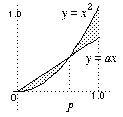 (b - a)d
(b - a)d (f, g).
(f, g).Hence prove that if a sequence (fn) in C[a, b] converges to a function f in d
 it also converges to f in d1.
it also converges to f in d1.
Given
 > 0, there exists N
> 0, there exists N  N such that m, n > N
N such that m, n > N  d(xm, xn) <
d(xm, xn) <  .
.Let (fn) be the sequence of functions on [-1, 1] defined by
fn(x) = 0 for x
 0, fn(x) = nx for 0 < x < 1/n and fn(x) = 1 for x
0, fn(x) = nx for 0 < x < 1/n and fn(x) = 1 for x  1/n.
1/n.Sketch the graphs of a typical pair of functions fm and fn and hence or otherwise prove that the sequence (fn) is a Cauchy sequence in C[-1, 1] with the metric d1.
Calculate the pointwise limit of the sequence (fn) and hence prove that the sequence (fn) is not a convergent sequence in C[-1, 1] under this metric.
 .
. Find the best-fit straight-line through the origin to the function x2 in the metric d1 .
Find the best-fit straight-line through the origin to the function x2 in the metric d1 . That is, find the value of a which minimises d1(x2, ax).
For this you have to minimise the shaded area. Calculate this area by first finding the x-coordinate of the point P in terms of a.
 Find the best-fit straight-line through the origin to the function x2 in the metric d
Find the best-fit straight-line through the origin to the function x2 in the metric d .
.
That is, find the value of a which minimises d (x2, ax).
(x2, ax).
For this you have to choose a so that the "vertical distance between the graphs" is a minimum. From the picture, you can see that the best you can do is to adjust the value of a so that the two dark lines have equal length.
Calculate d2(x2, ax) and then use the usual calculus method for finding the maximal value of a function to find the best-fit straight-line through the origin to the function x2 in the metric d2 .